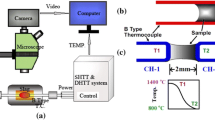Abstract
During the solidification process of peritectic steel (PS), the peritectic reaction often causes volume contraction which associated with surface longitudinal cracks, and using mould flux with low heat flux density help for alleviating surface longitudinal cracks. New peritectic steel mold flux with Co2O3 do** reduced the heat flux density, and the optimal content was found to be 2.0 wt %. Furthermore, basicity and Na2O addition were designed, and the minimum heat flux density required basicity of 1.4 and 10.0 wt %. Na2O content. As a result, the optimal peritectic composition was CaO(35.67wt%), SiO2(25.48 wt %),Al2O3(3.7 wt %), MgO(2.53 wt %),Na2O(10 wt %),CaF2(14 wt %),Co2O3(2 wt %).
Access this chapter
Tax calculation will be finalised at checkout
Purchases are for personal use only
Preview
Unable to display preview. Download preview PDF.
Similar content being viewed by others
References
P. Tang, G. H. Wen, C. S. Xu, H. X. Hong, G. J. Hen, J. B. Wang, and W. F. Li, “Mold Powder Used for Slab Casting of Container Sheet Steel,” Journal Of Iron & Steel Research International, 17(2) (2005), 16–18.
J. H. Chi and Y. N. Gan, Mold Fluxes (Shen Yang, SY: Northeastern University Press., 2000), 111.
M. Kawamoto, Y. Tsukaguchi, N. Nishida, T. Kanazawa and S. Hiraki, “Improvement of the Initial Stage of Solidification by Using Mild Cooling Mold Powder,” ISIJ International, 37(2) (1997), 134–139
J. Diao, B. **e, J. **ao et al.,“Radiative Heat Transfer In Transition Metal Oxides Contained In Mold Fluxes,” ISIJ International, 49(11) (2009), 1710–1714.
M. Susa, A. Kushimoto, H. Toyota et al., “Effects of Both Crystallization and Iron Oxides on the Radiative Heat Transfer in Mould Fluxes,” ISIJ International, 49(11) (2009), 1722–1729.
W. L. Wang, K. Blazek, A. W. Cramb et al., “Study Of The Crystallization Behavior Of A New Mold Flux Used In The Casting Of Transformation-Induced-Plasticity Steels,” Metallurgical And Materials Transactions B, 39(1) (2008), 66–74.
L. **ao, S. P. HE, J. F. XU, X. L. HUO and Q. WANG, “Properties of High Basicity Mold Fluxes for Peritectic Steel Slab Casting ,” Journal Of Iron And Steel Research International, 19(7) (2012), 39–45.
G. X. HU, “Influence of Na2O Content on Crystallization Properties of Mold Fluxes,” Foundry Technology, 33 (8) (2012), 964–966 (in Chinese).
S. P. HE, Q. WANG, D. **e, C. S. Xu, and K. C. Mills, “Solidification and crystallization properties of Cao-SiO2-Na2O Based mold fluxes,” International Journal of Minerals, Metallurgy And Materials, 16(3) (2009), 261–264.




